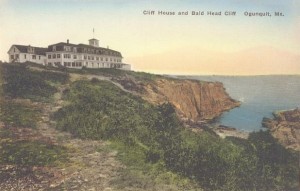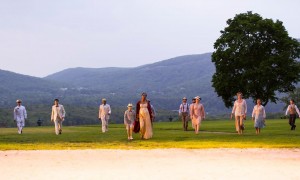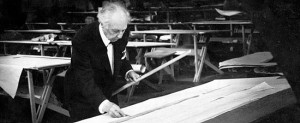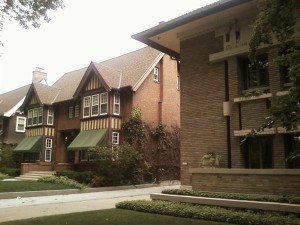 The Jimi Hendrix Experience is interviewed on the CBC. The other members of the group are Noel Redding on bass and Mitch Mitchell on drums. The interview was conducted by Terry David Mulligan in Vancouver on September 7, 1968:
The Jimi Hendrix Experience is interviewed on the CBC. The other members of the group are Noel Redding on bass and Mitch Mitchell on drums. The interview was conducted by Terry David Mulligan in Vancouver on September 7, 1968:
(This is the latest in a series of arts-related videos that appear in this space each Monday, Wednesday, and Friday.)


 Mrs. T and I are hitting the road this afternoon for a desperately needed vacation on the coast of Maine. I can’t even begin to tell you how much the two of us need to get away from it all, and that’s exactly what we intend to do.
Mrs. T and I are hitting the road this afternoon for a desperately needed vacation on the coast of Maine. I can’t even begin to tell you how much the two of us need to get away from it all, and that’s exactly what we intend to do. •
•  Twenty years ago Our Girl in Chicago took me on a tour of Frank Lloyd Wright’s self-designed home in Oak Park, Illinois. It was the beginning of what was soon to become a full-blown obsession. Since then I’ve toured fourteen of the thirty-seven Wright houses that are currently open to the public, spent the night in six of them (two more than once), and viewed the exteriors of dozens of other Wright-designed buildings of various kinds.
Twenty years ago Our Girl in Chicago took me on a tour of Frank Lloyd Wright’s self-designed home in Oak Park, Illinois. It was the beginning of what was soon to become a full-blown obsession. Since then I’ve toured fourteen of the thirty-seven Wright houses that are currently open to the public, spent the night in six of them (two more than once), and viewed the exteriors of dozens of other Wright-designed buildings of various kinds. Milwaukee contains five buildings designed by Wright, most of them private residences. More often than not, his houses were commissioned by people who had a fair amount of money to spend, meaning that they were either built on large sites that are still surrounded by trees or in upscale neighborhoods that have stayed that way. The Bogk House, a two-story masonry residence built in 1916, is one of the latter, and it makes an impression that will be familiar to anyone who goes out of his way to look at Wright houses. It’s an unostentatious building that fits perfectly onto its small lot and is surrounded by far more imposing homes, but no sooner do you catch sight of the Bogk House than they all seem to disappear from view.
Milwaukee contains five buildings designed by Wright, most of them private residences. More often than not, his houses were commissioned by people who had a fair amount of money to spend, meaning that they were either built on large sites that are still surrounded by trees or in upscale neighborhoods that have stayed that way. The Bogk House, a two-story masonry residence built in 1916, is one of the latter, and it makes an impression that will be familiar to anyone who goes out of his way to look at Wright houses. It’s an unostentatious building that fits perfectly onto its small lot and is surrounded by far more imposing homes, but no sooner do you catch sight of the Bogk House than they all seem to disappear from view. Some of Wright’s older houses, however, are located in areas that have changed greatly since they were built. Such is the case with the two small Wright houses and four duplexes that share a single block in Milwaukee’s Burnham Park, which is on the other side of town from the Bogk House, not far from the airport. Built between 1915 and 1916, they were known as
Some of Wright’s older houses, however, are located in areas that have changed greatly since they were built. Such is the case with the two small Wright houses and four duplexes that share a single block in Milwaukee’s Burnham Park, which is on the other side of town from the Bogk House, not far from the airport. Built between 1915 and 1916, they were known as  The most striking of the Burnham Park residences, known to scholars and specialists as the
The most striking of the Burnham Park residences, known to scholars and specialists as the  The house sits in a heavily wooded lot on a block full of ranch houses of similar vintage, all of them carefully kept and several of which were visibly influenced by Wright’s ideas about what he called “the small house problem.” Yet it, too, stands out from its surroundings, though not in high relief. The surrounding trees make the Rudin House somewhat hard to see from the street, and also give the present occupants (one of whom was home when I stopped by) a bit of much-needed privacy from pests like me.
The house sits in a heavily wooded lot on a block full of ranch houses of similar vintage, all of them carefully kept and several of which were visibly influenced by Wright’s ideas about what he called “the small house problem.” Yet it, too, stands out from its surroundings, though not in high relief. The surrounding trees make the Rudin House somewhat hard to see from the street, and also give the present occupants (one of whom was home when I stopped by) a bit of much-needed privacy from pests like me. I’ll be writing about my visit in the Journal next month, so I don’t want to say much about it now. Instead I’ll quote from what I wrote ten years ago:
I’ll be writing about my visit in the Journal next month, so I don’t want to say much about it now. Instead I’ll quote from what I wrote ten years ago: Now I’m back on the East Coast again, sitting in the living room of the century-old farmhouse apartment in rural Connecticut that I share with Mrs. T. It’s a pleasant space, one in which we’re more than content to live, but today I feel, as I always do after visiting a Frank Lloyd Wright house, that there isn’t much I wouldn’t give to spend the rest of my days in a building like the Rudin House. While I’m not one of those fanatics who has no interest in any other style, I’ve come to feel over the years that Wright’s approach to domestic architecture is completely in tune with my own sense of how to live.
Now I’m back on the East Coast again, sitting in the living room of the century-old farmhouse apartment in rural Connecticut that I share with Mrs. T. It’s a pleasant space, one in which we’re more than content to live, but today I feel, as I always do after visiting a Frank Lloyd Wright house, that there isn’t much I wouldn’t give to spend the rest of my days in a building like the Rudin House. While I’m not one of those fanatics who has no interest in any other style, I’ve come to feel over the years that Wright’s approach to domestic architecture is completely in tune with my own sense of how to live.